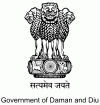Daman and Diu (Union Territory of Damān and Diu)
 |
For over 450 years, the coastal enclaves of Daman (Portuguese: Damão) and Diu on the Arabian Sea coast were part of Portuguese India, along with Goa and Dadra and Nagar Haveli. Goa, Daman and Diu were incorporated into the Republic of India on 19 December 1961, by military conquest. Portugal did not recognise the Indian annexation of these territories until the Carnation Revolution of 1974. The territory has also been ruled by Kolis.
The territory of Goa, Daman and Diu was administered as a single union territory until 30 May 1987, when Goa was granted statehood, leaving Daman and Diu as a separate union territory. Each enclave constituted one of the union territory's two districts. Daman and Diu are approximately 650 kilometres away from each other by road.
On 3 November 2019, Daman Collector Rakesh Minhas issued a Section 144 order banning peaceful assembly of four or more persons, slogan-shouting and the use of loudspeakers across the entire district and ordered the conversion of Government High School, Bhimpore and the Government Sarvottam High School, Moti Daman into 'temporary jails'. This was in response to a land ownership dispute between the local indigenous fishing community and the local administration that had confiscated their land and bulldozed their homes. The ensuing 2019 Daman Indigenous Land Clearing Protests resulted with the detention of 70 protesters in the 'temporary jails' and another 8 arrests. Few of the adivasi fisherfolk were rehoused whilst most languished traumatised and homeless on the streets near the rubble of their razed homes.
In December 2019, the Parliament of India passed legislation to merge Daman and Diu with the nearby union territory of Dadra and Nagar Haveli to create a new union territory to be known as Dadra and Nagar Haveli and Daman and Diu.
Map - Daman and Diu (Union Territory of Damān and Diu)
Map
Country - India
 |
 |
| Flag of India | |
Modern humans arrived on the Indian subcontinent from Africa no later than 55,000 years ago. Their long occupation, initially in varying forms of isolation as hunter-gatherers, has made the region highly diverse, second only to Africa in human genetic diversity. Settled life emerged on the subcontinent in the western margins of the Indus river basin 9,000 years ago, evolving gradually into the Indus Valley Civilisation of the third millennium BCE. By, an archaic form of Sanskrit, an Indo-European language, had diffused into India from the northwest. (a) (b) (c), "In Punjab, a dry region with grasslands watered by five rivers (hence ‘panch’ and ‘ab’) draining the western Himalayas, one prehistoric culture left no material remains, but some of its ritual texts were preserved orally over the millennia. The culture is called Aryan, and evidence in its texts indicates that it spread slowly south-east, following the course of the Yamuna and Ganga Rivers. Its elite called itself Arya (pure) and distinguished themselves sharply from others. Aryans led kin groups organized as nomadic horse-herding tribes. Their ritual texts are called Vedas, composed in Sanskrit. Vedic Sanskrit is recorded only in hymns that were part of Vedic rituals to Aryan gods. To be Aryan apparently meant to belong to the elite among pastoral tribes. Texts that record Aryan culture are not precisely datable, but they seem to begin around 1200 BCE with four collections of Vedic hymns (Rg, Sama, Yajur, and Artharva)."
Currency / Language
| ISO | Currency | Symbol | Significant figures |
|---|---|---|---|
| INR | Indian rupee | ₹ | 2 |
| ISO | Language |
|---|---|
| AS | Assamese language |
| BN | Bengali language |
| BH | Bihari languages |
| EN | English language |
| GU | Gujarati language |
| HI | Hindi |
| KN | Kannada language |
| ML | Malayalam language |
| MR | Marathi language |
| OR | Oriya language |
| PA | Panjabi language |
| TA | Tamil language |
| TE | Telugu language |
| UR | Urdu |















